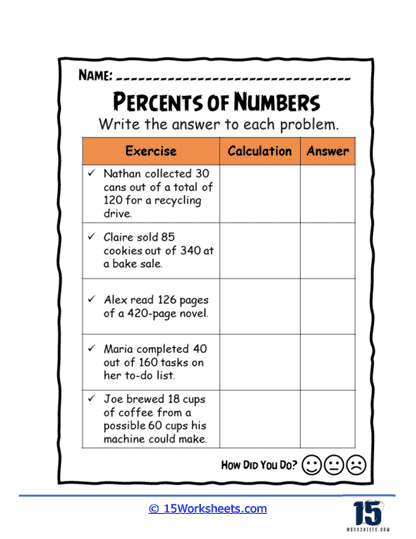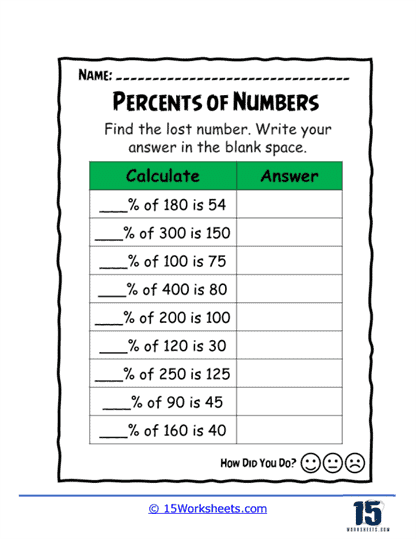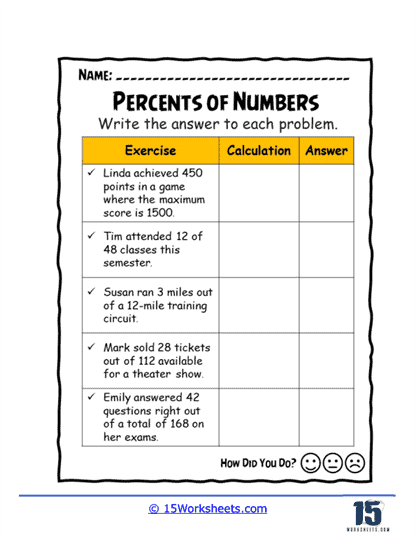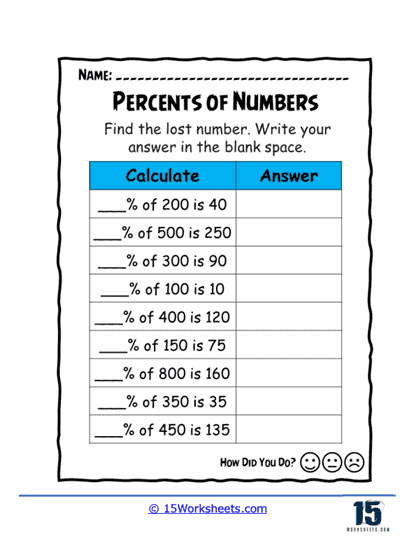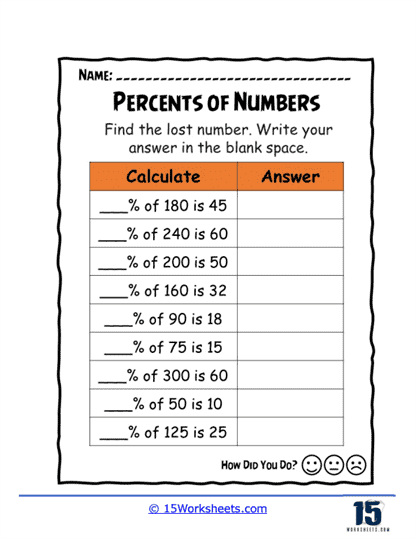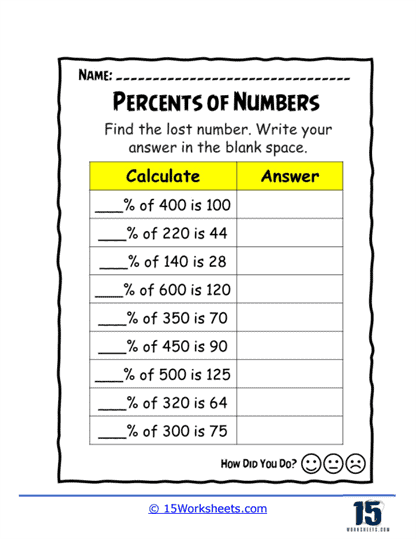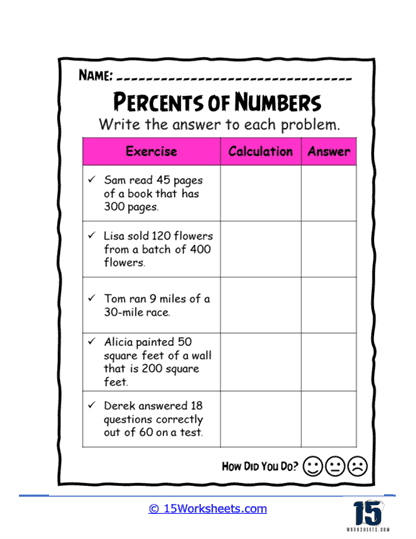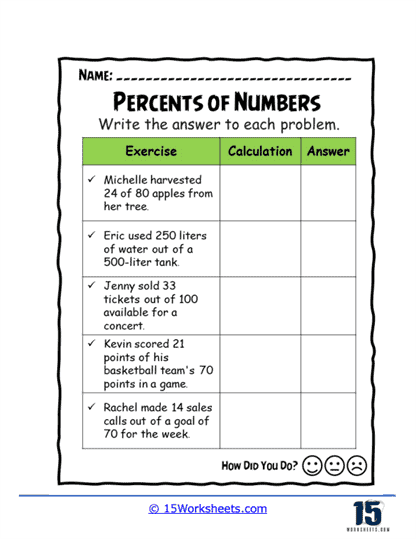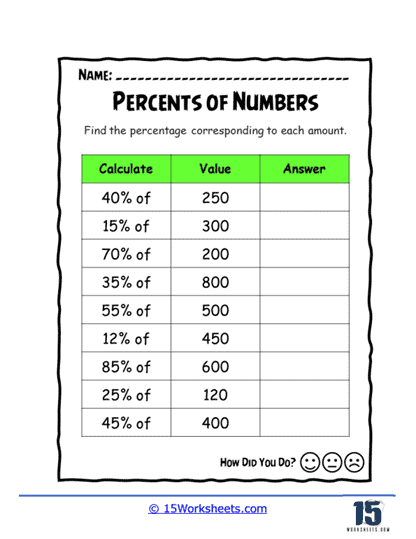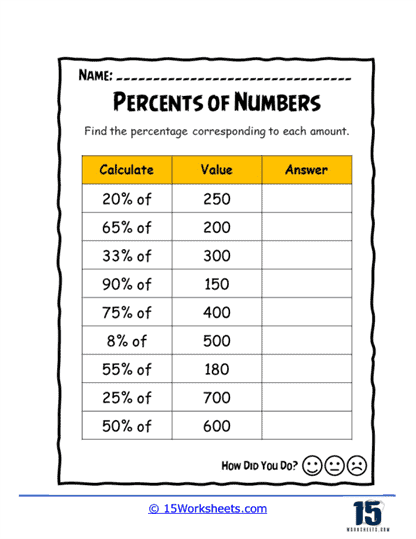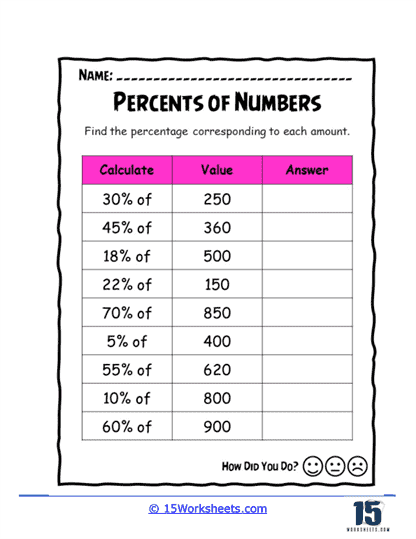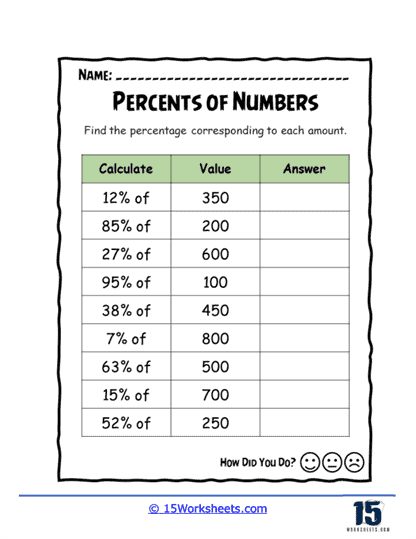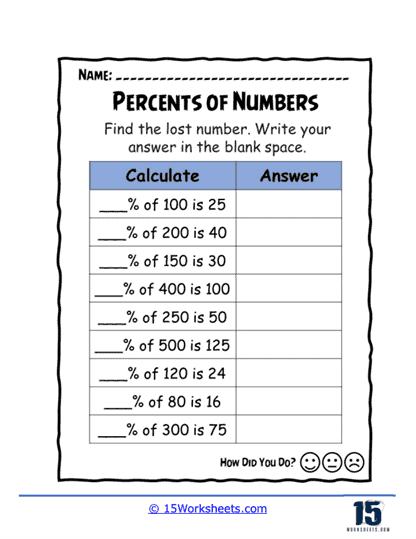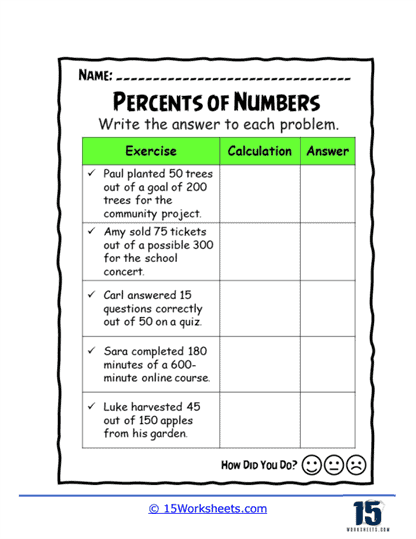Percentages of Numbers Worksheets
About These 15 Worksheets
These worksheets will help students grasp the concept of percentages and how they relate to various numerical values. These worksheets provide a structured way for students to practice calculating percentages, understanding their practical applications, and strengthening their overall mathematical skills. The exercises presented in these worksheets are designed to be progressively challenging, catering to different levels of student understanding, from basic percentage calculations to more complex word problems that require critical thinking.
One common type of exercise found in the worksheets is the straightforward percentage calculation. In these problems, students are given a percentage and a number, and they must calculate the percentage of that number. For example, a student might be asked to find 25% of 200. This type of problem helps students understand the basic concept that a percentage is a part of a whole and that calculating a percentage of a number is essentially finding that fraction of the total. These exercises are fundamental in teaching students how to handle percentages and provide a solid foundation for more complex calculations.
Another type of exercise that often appears on these worksheets involves finding the missing percentage or the base number when given a percentage and its corresponding value. For instance, students might be given that 25 is a certain percentage of 100 and be asked to find what that percentage is. Alternatively, they might be told that 50 is 10% of some number and need to determine the original number. These problems require students to reverse their thinking and apply their understanding of percentages in a different way, which helps to deepen their comprehension and improve their problem-solving abilities.
In addition to these more straightforward calculations, the exercises also include word problems that apply percentage concepts to real-world scenarios. These problems might involve situations like calculating discounts during a sale, determining the percentage of a goal that has been achieved, or figuring out how much of a total quantity has been used or remains. For example, a problem might state that a student has completed 75 out of 100 math problems and ask what percentage this represents. These word problems are particularly valuable because they help students see the relevance of percentages in everyday life and teach them how to apply their mathematical knowledge in practical situations.
Some worksheets go a step further by integrating percentages into more complex mathematical concepts. For instance, students might be asked to calculate the percentage of a number in a multi-step problem that involves additional operations like multiplication or division. An example could be determining what percentage of a group of students who passed an exam represents a certain fraction of the total number of students who took the exam. These types of problems not only reinforce students’ understanding of percentages but also challenge them to use their critical thinking and analytical skills to solve more intricate mathematical scenarios.
The variety of exercises found in these worksheets ensures that students get comprehensive practice with percentages, from basic calculations to more advanced applications. This variety is crucial because it addresses the different ways in which students learn and understand mathematical concepts. Some students may excel with straightforward calculations but struggle with word problems, while others may find the reverse to be true. By including a range of problem types, these worksheets cater to diverse learning styles and help all students build a well-rounded understanding of percentages.
In terms of the specific math skills taught, these worksheets are invaluable in several areas. First and foremost, they teach students how to calculate percentages accurately. This skill is foundational in many areas of math and is also widely applicable in everyday situations, such as calculating tips, understanding sales discounts, or interpreting data in charts and graphs. Additionally, by requiring students to find missing values or work through word problems, these worksheets also teach critical thinking and problem-solving skills. Students learn how to break down a problem, identify the relevant information, and apply the correct mathematical operations to arrive at a solution.
This series of sheets will reinforce other key mathematical concepts, such as fractions and decimals. Because percentages are essentially another way of expressing fractions (with a denominator of 100), these exercises help students see the connections between different forms of numbers. They might be asked to convert a percentage into a fraction or a decimal as part of solving a problem, which reinforces their understanding of how these different numerical representations relate to one another. This, in turn, strengthens their overall number sense and prepares them for more advanced math topics.
Another important aspect of these worksheets is that they help students develop their ability to work with proportional relationships. Many of the problems require students to understand and manipulate proportions, whether they are calculating what portion of a whole a certain percentage represents or determining the original amount based on a percentage. Proportional reasoning is a critical skill in math, and practicing with percentages helps students build a strong foundation in this area.
Finding the Percentages of Numbers
Determining the percentage of a number is a fundamental mathematical skill that involves calculating a portion of a given number based on a specified percentage. The process is straightforward and involves converting the percentage into a more usable form (such as a decimal) and then applying that to the number in question. Here’s a step-by-step guide to determining the percentage of a number, followed by a detailed example.
Step #1 – Understand What a Percentage Represents
A percentage is a way of expressing a number as a fraction of 100. For example, 25% means 25 out of 100, or 25/100. When you are asked to find a percentage of a number, you are essentially determining how much of that number corresponds to a given fraction of 100.
Step #2 – Convert the Percentage to a Decimal
To make the calculation easier, convert the percentage to a decimal by dividing it by 100. For instance, 25% becomes 0.25. This step is crucial because it allows you to multiply the decimal by the number to find the portion that represents the given percentage.
Step #3 – Multiply the Decimal by the Number
Once you have converted the percentage to a decimal, multiply this decimal by the number you want to find the percentage of. This multiplication gives you the amount that corresponds to the specified percentage of that number.
Step #4 – Interpret the Result
The product of the multiplication is the value that represents the given percentage of the original number. This value is your final answer.
Example: Calculating 20% of 150
Step 1 – Understand What 20% Represents
We want to find 20% of 150. This means we are looking to find what part of 150 corresponds to 20% of it. In other words, we are dividing 150 into 100 equal parts and then taking 20 of those parts.
Step 2 – Convert the Percentage to a Decimal
First, we need to convert 20% into a decimal. We do this by dividing 20 by 100: 20/100 = 0.20
So, instead of working directly with 20%, we use the decimal 0.20.
Step 3 – Multiply the Decimal by the Number
Next, we multiply the decimal (0.20) by the number (150) to find the percentage of that number:
0.20 x 150 = 30
Step 4 – Interpret the Result
The result of this multiplication is 30. This means that 20% of 150 is 30.

